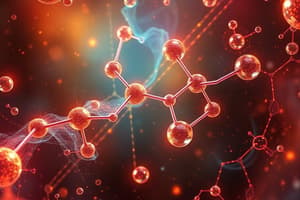Podcast
Questions and Answers
What is a hydrocarbon?
What is a hydrocarbon?
A hydrocarbon is an organic compound consisting entirely of hydrogen and carbon.
What are some characteristics of hydrocarbons?
What are some characteristics of hydrocarbons?
Hydrocarbons are generally colorless, hydrophobic, and have a faint odor similar to gasoline or lighter fluid.
What are the different phases in which hydrocarbons can exist?
What are the different phases in which hydrocarbons can exist?
Hydrocarbons can exist as gases (such as methane and propane), liquids (such as hexane and benzene), low melting solids (such as paraffin wax and naphthalene), or polymers (such as polyethylene and polystyrene).
In the fossil fuel industries, what does hydrocarbon refer to?
In the fossil fuel industries, what does hydrocarbon refer to?
What is the main source of the world's energy?
What is the main source of the world's energy?
What is Markovnikov's rule in organic chemistry?
What is Markovnikov's rule in organic chemistry?
Who formulated Markovnikov's rule?
Who formulated Markovnikov's rule?
What happens when a protic acid is added to an asymmetric alkene according to Markovnikov's rule?
What happens when a protic acid is added to an asymmetric alkene according to Markovnikov's rule?
How does Markovnikov's rule differ from its original definition?
How does Markovnikov's rule differ from its original definition?
What happens when an alkene reacts with water according to Markovnikov's rule?
What happens when an alkene reacts with water according to Markovnikov's rule?
Flashcards are hidden until you start studying
Study Notes
Hydrocarbons
- Hydrocarbons are organic compounds consisting entirely of hydrogen and carbon.
- They are examples of group 14 hydrides.
- Hydrocarbons are generally colorless and hydrophobic, with a faint odor similar to gasoline or lighter fluid.
- They occur in a diverse range of molecular structures and phases, including gases (e.g., methane and propane), liquids (e.g., hexane and benzene), low melting solids (e.g., paraffin wax and naphthalene), and polymers (e.g., polyethylene and polystyrene).
Fossil Fuels and Energy
- In the fossil fuel industries, hydrocarbon refers to naturally occurring petroleum, natural gas, and coal, or their hydrocarbon derivatives and purified forms.
- Combustion of hydrocarbons is the main source of the world's energy.
- Petroleum is the dominant raw-material source for organic commodity chemicals such as solvents and polymers.
Greenhouse Gas Emissions
- Most anthropogenic (human-generated) emissions of greenhouse gases are either carbon dioxide released.
Markovnikov's Rule
Definition and Explanation
- Markovnikov's rule describes the outcome of some addition reactions in organic chemistry.
- The rule was formulated by Russian chemist Vladimir Markovnikov in 1870.
- The rule states that with the addition of a protic acid HX or other polar reagent to an asymmetric alkene:
- The acid hydrogen (H) or electropositive part gets attached to the carbon with more hydrogen substituents.
- The halide (X) group or electronegative part gets attached to the carbon with more alkyl substituents.
Contrast to Original Definition
- The original definition of Markovnikov's rule states that:
- The X component is added to the carbon with the fewest hydrogen atoms.
- The hydrogen atom is added to the carbon with the greatest number of hydrogen atoms.
Studying That Suits You
Use AI to generate personalized quizzes and flashcards to suit your learning preferences.




